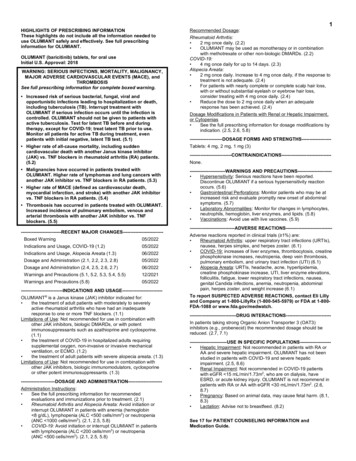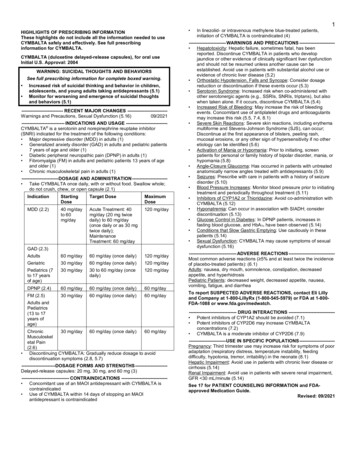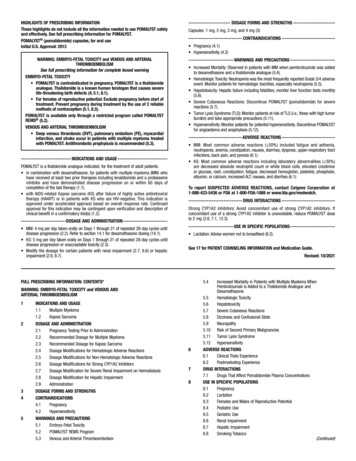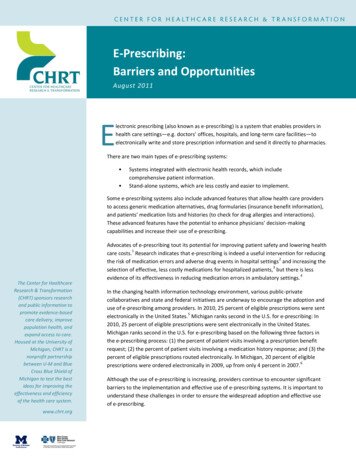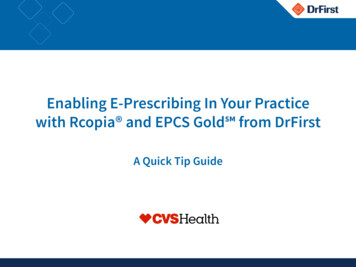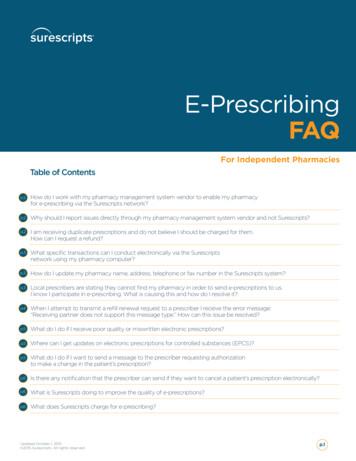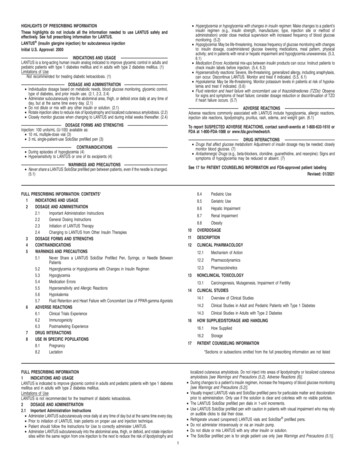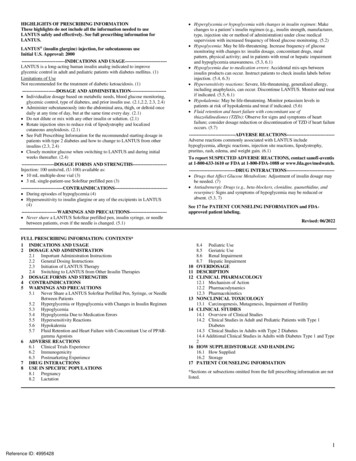
Transcription
HIGHLIGHTS OF PRESCRIBING INFORMATIONThese highlights do not include all the information needed to useLANTUS safely and effectively. See full prescribing information forLANTUS.LANTUS (insulin glargine) injection, for subcutaneous useInitial U.S. Approval: 2000----------------------------INDICATIONS AND USAGE--------------------------LANTUS is a long-acting human insulin analog indicated to improveglycemic control in adult and pediatric patients with diabetes mellitus. (1)Limitations of UseNot recommended for the treatment of diabetic ketoacidosis. (1)----------------------DOSAGE AND ADMINISTRATION---------------------- Individualize dosage based on metabolic needs, blood glucose monitoring,glycemic control, type of diabetes, and prior insulin use. (2.1,2.2, 2.3, 2.4) Administer subcutaneously into the abdominal area, thigh, or deltoid oncedaily at any time of day, but at the same time every day. (2.1) Do not dilute or mix with any other insulin or solution. (2.1) Rotate injection sites to reduce risk of lipodystrophy and localizedcutaneous amyloidosis. (2.1) See Full Prescribing Information for the recommended starting dosage inpatients with type 2 diabetes and how to change to LANTUS from otherinsulins (2.3, 2.4) Closely monitor glucose when switching to LANTUS and during initialweeks thereafter. (2.4)---------------------DOSAGE FORMS AND STRENGTHS---------------------Injection: 100 units/mL (U-100) available as: 10 mL multiple-dose vial (3) 3 mL single-patient-use SoloStar prefilled pen ------------------------------ During episodes of hypoglycemia (4) Hypersensitivity to insulin glargine or any of the excipients in LANTUS(4)-----------------------WARNINGS AND PRECAUTIONS----------------------- Never share a LANTUS SoloStar prefilled pen, insulin syringe, or needlebetween patients, even if the needle is changed. (5.1)FULL PRESCRIBING INFORMATION: CONTENTS*1 INDICATIONS AND USAGE2 DOSAGE AND ADMINISTRATION2.1 Important Administration Instructions2.2 General Dosing Instructions2.3 Initiation of LANTUS Therapy2.4 Switching to LANTUS from Other Insulin Therapies3 DOSAGE FORMS AND STRENGTHS4 CONTRAINDICATIONS5 WARNINGS AND PRECAUTIONS5.1 Never Share a LANTUS SoloStar Prefilled Pen, Syringe, or NeedleBetween Patients5.2 Hyperglycemia or Hypoglycemia with Changes in Insulin Regimen5.3 Hypoglycemia5.4 Hypoglycemia Due to Medication Errors5.5 Hypersensitivity Reactions5.6 Hypokalemia5.7 Fluid Retention and Heart Failure with Concomitant Use of PPARgamma Agonists6 ADVERSE REACTIONS6.1 Clinical Trials Experience6.2 Immunogenicity6.3 Postmarketing Experience7 DRUG INTERACTIONS8 USE IN SPECIFIC POPULATIONS8.1 Pregnancy8.2 Lactation Hyperglycemia or hypoglycemia with changes in insulin regimen: Makechanges to a patient’s insulin regimen (e.g., insulin strength, manufacturer,type, injection site or method of administration) under close medicalsupervision with increased frequency of blood glucose monitoring. (5.2) Hypoglycemia: May be life-threatening. Increase frequency of glucosemonitoring with changes to: insulin dosage, concomitant drugs, mealpattern, physical activity; and in patients with renal or hepatic impairmentand hypoglycemia unawareness. (5.3, 6.1) Hypoglycemia due to medication errors: Accidental mix-ups betweeninsulin products can occur. Instruct patients to check insulin labels beforeinjection. (5.4, 6.3) Hypersensitivity reactions: Severe, life-threatening, generalized allergy,including anaphylaxis, can occur. Discontinue LANTUS. Monitor and treatif indicated. (5.5, 6.1) Hypokalemia: May be life-threatening. Monitor potassium levels inpatients at risk of hypokalemia and treat if indicated. (5.6) Fluid retention and heart failure with concomitant use ofthiazolidinediones (TZDs): Observe for signs and symptoms of heartfailure; consider dosage reduction or discontinuation of TZD if heart failureoccurs. (5.7)------------------------------ADVERSE REACTIONS------------------------------Adverse reactions commonly associated with LANTUS includehypoglycemia, allergic reactions, injection site reactions, lipodystrophy,pruritus, rash, edema, and weight gain. (6.1)To report SUSPECTED ADVERSE REACTIONS, contact sanofi-aventisat 1-800-633-1610 or FDA at 1-800-FDA-1088 or -DRUG INTERACTIONS------------------------------ Drugs that Affect Glucose Metabolism: Adjustment of insulin dosage maybe needed. (7) Antiadrenergic Drugs (e.g., beta-blockers, clonidine, guanethidine, andreserpine): Signs and symptoms of hypoglycemia may be reduced orabsent. (5.3, 7)See 17 for PATIENT COUNSELING INFORMATION and FDAapproved patient labeling.Revised: 06/2022101112131416178.4 Pediatric Use8.5 Geriatric Use8.6 Renal Impairment8.7 Hepatic ImpairmentOVERDOSAGEDESCRIPTIONCLINICAL PHARMACOLOGY12.1 Mechanism of Action12.2 Pharmacodynamics12.3 PharmacokineticsNONCLINICAL TOXICOLOGY13.1 Carcinogenesis, Mutagenesis, Impairment of FertilityCLINICAL STUDIES14.1 Overview of Clinical Studies14.2 Clinical Studies in Adult and Pediatric Patients with Type 1Diabetes14.3 Clinical Studies in Adults with Type 2 Diabetes14.4 Additional Clinical Studies in Adults with Diabetes Type 1 and Type2HOW SUPPLIED/STORAGE AND HANDLING16.1 How Supplied16.2 StoragePATIENT COUNSELING INFORMATION*Sections or subsections omitted from the full prescribing information are notlisted.1Reference ID: 4995428
FULL PRESCRIBING INFORMATION1INDICATIONS AND USAGELANTUS is indicated to improve glycemic control in adult and pediatric patients with diabetesmellitus.Limitations of UseLANTUS is not recommended for the treatment of diabetic ketoacidosis.2DOSAGE AND ADMINISTRATION2.1Important Administration Instructions Always check insulin labels before administration [see Warnings and Precautions (5.4)]Visually inspect LANTUS vials and SoloStar prefilled pens for particulate matter anddiscoloration prior to administration. Only use if the solution is clear and colorless with novisible particles.Administer LANTUS subcutaneously into the abdominal area, thigh, or deltoid, and rotateinjection sites within the same region from one injection to the next to reduce the risk oflipodystrophy and localized cutaneous amyloidosis. Do not inject into areas of lipodystrophyor localized cutaneous amyloidosis [see Warnings and Precautions (5.2) and AdverseReactions (6)].During changes to a patient’s insulin regimen, increase the frequency of blood glucosemonitoring [see Warnings and Precautions (5.2)].Do not administer intravenously or via an insulin pump.Do not dilute or mix LANTUS with any other insulin or solution.The LANTUS SoloStar prefilled pen dials in 1-unit increments.Use LANTUS SoloStar prefilled pen with caution in patients with visual impairment whomay rely on audible clicks to dial their dose.2.2 General Dosing InstructionsAdminister LANTUS subcutaneously once daily at any time of day but at the same timeevery day.Individualize and adjust the dosage of LANTUS based on the patient’s metabolic needs,blood glucose monitoring results and glycemic control goal.Dosage adjustments may be needed with changes in physical activity, changes in mealpatterns (i.e., macronutrient content or timing of food intake), during acute illness, or changesin renal or hepatic function. Dosage adjustments should only be made under medicalsupervision with appropriate glucose monitoring [see Warnings and Precautions (5.2)].In patients with type 1 diabetes, LANTUS must be used concomitantly with short-actinginsulin.2.3Initiation of LANTUS TherapyRecommended Starting Dosage in Patients with Type 1 Diabetes2Reference ID: 4995428
The recommended starting dosage of LANTUS in patients with type 1 diabetes is approximatelyone-third of the total daily insulin requirements. Use short-acting, premeal insulin to satisfy theremainder of the daily insulin requirements.Recommended Starting Dosage in Patients with Type 2 DiabetesThe recommended starting dosage of LANTUS in patients with type 2 diabetes who are notcurrently treated with insulin is 0.2 units/kg or up to 10 units once daily.2.4Switching to LANTUS from Other Insulin TherapiesDosage adjustments are recommended to lower the risk of hypoglycemia when switchingpatients to LANTUS from other insulin therapies [see Warnings and Precautions (5.3)].When switching from: Once-daily TOUJEO (insulin glargine 300 units/mL) to once-daily LANTUS (100 units/mL),the recommended starting LANTUS dosage is 80% of the TOUJEO dosage that is beingdiscontinued.Once-daily NPH insulin to once-daily LANTUS, the recommended starting LANTUS dosageis the same as the dosage of NPH that is being discontinued.Twice-daily NPH insulin to once-daily LANTUS, the recommended starting LANTUSdosage is 80% of the total NPH dosage that is being discontinued.3DOSAGE FORMS AND STRENGTHSInjection: 100 units/mL (U-100) a clear and colorless solution available as: 410 mL multiple-dose vial3 mL single-patient-use LANTUS SoloStar prefilled penCONTRAINDICATIONSLANTUS is contraindicated: During episodes of hypoglycemia [see Warnings and Precautions (5.3)]In patients with hypersensitivity to insulin glargine or any of the excipients in LANTUS[see Warnings and Precautions (5.5)]5WARNINGS AND PRECAUTIONS5.1Never Share a LANTUS SoloStar Prefilled Pen, Insulin Syringe, or NeedleBetween PatientsLANTUS SoloStar prefilled pens must never be shared between patients, even if the needle ischanged. Patients using LANTUS vials must never re-use or share needles or syringes withanother person. Sharing poses a risk for transmission of blood-borne pathogens.5.2Hyperglycemia or Hypoglycemia with Changes in Insulin RegimenChanges in an insulin regimen (e.g., insulin strength, manufacturer, type, injection site or methodof administration) may affect glycemic control and predispose to hypoglycemia [see Warningsand Precautions (5.3)] or hyperglycemia. Repeated insulin injections into areas of lipodystrophyor localized cutaneous amyloidosis have been reported to result in hyperglycemia; and a sudden3Reference ID: 4995428
change in the injection site (to unaffected area) has been reported to result in hypoglycemia [seeAdverse Reactions (6)].Make any changes to a patient’s insulin regimen under close medical supervision with increasedfrequency of blood glucose monitoring. Advise patients who have repeatedly injected into areasof lipodystrophy or localized cutaneous amyloidosis to change the injection site to unaffectedareas and closely monitor for hypoglycemia. For patients with type 2 diabetes, dosageadjustments of concomitant oral and antidiabetic products may be needed.5.3HypoglycemiaHypoglycemia is the most common adverse reaction associated with insulins, includingLANTUS. Severe hypoglycemia can cause seizures, may be life-threatening or cause death.Hypoglycemia can impair concentration ability and reaction time; this may place the patient andothers at risk in situations where these abilities are important (e.g., driving or operating othermachinery).Hypoglycemia can happen suddenly, and symptoms may differ in each patient and change overtime in the same patient. Symptomatic awareness of hypoglycemia may be less pronounced inpatients with longstanding diabetes, in patients with diabetic neuropathy, using drugs that blockthe sympathetic nervous system (e.g., beta-blockers) [see Drug Interactions (7)], or whoexperience recurrent hypoglycemia.The long-acting effect of LANTUS may delay recovery from hypoglycemia.Risk Factors for HypoglycemiaThe risk of hypoglycemia after an injection is related to the duration of action of the insulin and,in general, is highest when the glucose lowering effect of the insulin is maximal. As with allinsulins, the glucose lowering effect time course of LANTUS may vary in different patients or atdifferent times in the same patient and depends on many conditions, including the area ofinjection as well as the injection site blood supply and temperature [see Clinical Pharmacology(12.2)]. Other factors which may increase the risk of hypoglycemia include changes in mealpattern (e.g., macronutrient content or timing of meals), changes in level of physical activity, orchanges to concomitant drugs [see Drug Interactions (7)]. Patients with renal or hepaticimpairment may be at higher risk of hypoglycemia [see Use in Specific Populations (8.6, 8.7)].Risk Mitigation Strategies for HypoglycemiaPatients and caregivers must be educated to recognize and manage hypoglycemia. Selfmonitoring of blood glucose plays an essential role in the prevention and management ofhypoglycemia. In patients at higher risk for hypoglycemia and patients who have reducedsymptomatic awareness of hypoglycemia, increased frequency of blood glucose monitoring isrecommended.5.4Hypoglycemia Due to Medication ErrorsAccidental mix-ups among insulin products have been reported. To avoid medication errorsbetween LANTUS and other insulins, instruct patients to always check the insulin label beforeeach injection [see Adverse Reactions (6.3)].5.5Hypersensitivity Reactions4Reference ID: 4995428
Severe, life-threatening, generalized allergy, including anaphylaxis, can occur with insulins,including LANTUS [see Adverse Reactions (6.1)]. If hypersensitivity reactions occur,discontinue LANTUS; treat per standard of care and monitor until symptoms and signs resolve.LANTUS is contraindicated in patients who have had hypersensitivity reactions to insulinglargine or one of the excipients.5.6HypokalemiaAll insulins, including LANTUS, cause a shift in potassium from the extracellular to intracellularspace, possibly leading to hypokalemia. Untreated hypokalemia may cause respiratory paralysis,ventricular arrhythmia, and death. Monitor potassium levels in patients at risk for hypokalemia,if indicated (e.g., patients using potassium-lowering medications, patients taking medicationssensitive to serum potassium concentrations).5.7Fluid Retention and Heart Failure with Concomitant Use of PPAR-gammaAgonistsThiazolidinediones (TZDs), which are peroxisome proliferator-activated receptor (PPAR)gamma agonists, can cause dose-related fluid retention, when used in combination with insulin.Fluid retention may lead to or exacerbate heart failure. Patients treated with insulin, includingLANTUS, and a PPAR-gamma agonist should be observed for signs and symptoms of heartfailure. If heart failure develops, it should be managed according to current standards of care, anddiscontinuation or dose reduction of the PPAR-gamma agonist must be considered.6ADVERSE REACTIONSThe following adverse reactions are discussed elsewhere: 6.1Hypoglycemia [see Warnings and Precautions (5.3)]Hypoglycemia Due to Medication Errors [see Warnings and Precautions (5.4)]Hypersensitivity Reactions [see Warnings and Precautions (5.5)]Hypokalemia [see Warnings and Precautions (5.6)]Clinical Trials ExperienceBecause clinical trials are conducted under widely varying conditions, adverse reaction ratesobserved in clinical trials of a drug cannot be directly compared to rates in the clinical trial ofanother drug and may not reflect the rates observed in practice.The data in Table 1 reflect the exposure of 2,327 patients with type 1 diabetes to LANTUS orNPH in Studies A, B, C, and D [see Clinical Studies (14.2)]. The type 1 diabetes population hadthe following characteristics: Mean age was 39 years. Fifty-four percent were male, 97% wereCaucasian, 22% were Black or African American and 33% were Hispanic. The mean BMI was25.1 kg/m2.The data in Table 2 reflect the exposure of 1,563 patients with type 2 diabetes to LANTUS orNPH in Studies E, F, and G [see Clinical Studies (14.3)]. The type 2 diabetes population had thefollowing characteristics: Mean age was 59 years. Fifty-eight percent were male, 87% wereCaucasian, 8% were Black or African American and 9% were Hispanic. The mean BMI was 29.2kg/m2.5Reference ID: 4995428
The frequencies of adverse reactions during LANTUS clinical studies in patients with type 1diabetes mellitus and type 2 diabetes mellitus are listed in the tables below (Tables 1, 2, 3, and4).Table 1: Adverse Reactions Occurring 5% in Pooled Clinical Studies up to 28 WeeksDuration in Adults with Type 1 DiabetesUpper respiratory tract infectionInfection*Accidental injuryHeadache* Body system not specifiedLANTUS, %(n 1,257)NPH, %(n 1,070)22.49.45.75.523.110.36.44.7Table 2: Adverse Reactions Occurring 5% in Pooled Clinical Studies up to 1 YearDuration in Adults with Type 2 DiabetesUpper respiratory tract infectionInfection*Retinal vascular disorder* Body system not specifiedLANTUS, %(n 849)11.410.45.8NPH, %(n 714)13.311.67.4Table 3: Adverse Reactions Occurring 10% in a 5-Year Study of Adults with Type 2DiabetesUpper respiratory tract infectionEdema onchitisArthralgiaPain in extremityBack painCoughUrinary tract infectionDiarrheaDepressionHeadacheLANTUS, %(n .710.710.510.3NPH, %(n 110.39.79.3Table 4: Adverse Reactions Occurring 5% in a 28-Week Clinical Study in PediatricPatients with Type 1 DiabetesInfection*Upper respiratory tract infectionPharyngitisRhinitisLANTUS, %(n 174)13.813.87.55.2NPH, %(n 175)17.716.08.65.16Reference ID: 4995428
* Body system not specifiedSevere HypoglycemiaHypoglycemia was the most commonly observed adverse reaction in patients treated withLANTUS. Tables 5, 6, and 7 summarize the incidence of severe hypoglycemia in the LANTUSclinical studies. Severe symptomatic hypoglycemia was defined as an event with symptomsconsistent with hypoglycemia requiring the assistance of another person and associated witheither a blood glucose below 50 mg/dL ( 56 mg/dL in the 5-year study and 36 mg/dL in theORIGIN study) or prompt recovery after oral carbohydrate, intravenous glucose, or glucagonadministration.Percentages of LANTUS-treated adult patients who experienced severe symptomatichypoglycemia in the LANTUS clinical studies [see Clinical Studies (14)] were comparable topercentages of NPH-treated patients for all treatment regimens (see Tables 5 and 6). In thepediatric clinical study, pediatric patients with type 1 diabetes had a higher incidence of severesymptomatic hypoglycemia in the two treatment groups compared to the adult studies with type1 diabetes.Table 5: Severe Symptomatic Hypoglycemia in Patients with Type 1 DiabetesStudy AType 1 DiabetesAdults28 weeksIn combination withregular insulinLANTUSNPHN 292N 293Percent ofpatients10.615.0Study BType 1 DiabetesAdults28 weeksIn combinationwith regular insulinLANTUSNPHN 264N 2708.710.4Study CType 1 DiabetesAdults16 weeksIn combination withinsulin lisproLANTUSNPHN 310N 3096.55.2Study DType 1 DiabetesPediatrics26 weeksIn combination withregular insulinLANTUSNPHN 174N 17523.028.6Table 6: Severe Symptomatic Hypoglycemia in Patients with Type 2 DiabetesStudy EType 2 DiabetesAdults52 weeksIn combination with oralagentsLANTUSNPHN 289N 281Percentofpatients1.71.1Study FType 2 DiabetesAdults28 weeksIn combination with regularinsulinLANTUSNPHN 259N 2590.4Study GType 2 DiabetesAdults5 yearsIn combination with regularinsulinLANTUSNPHN 513N 5042.37.811.9Table 7 displays the proportion of patients who experienced severe symptomatic hypoglycemiain the LANTUS and Standard Care groups in the ORIGIN study [see Clinical Studies (14)].Table 7: Severe Symptomatic Hypoglycemia in the ORIGIN StudyORIGIN StudyMedian duration of follow-up: 6.2 yearsLANTUSStandard CareN 6231N 62737Reference ID: 4995428
Percent of patients5.61.8Peripheral EdemaSome patients taking LANTUS have experienced sodium retention and edema, particularly ifpreviously poor metabolic control was improved by intensified insulin therapy.LipodystrophyAdministration of insulin subcutaneously, including LANTUS, has resulted in lipoatrophy(depression in the skin) or lipohypertrophy (enlargement or thickening of tissue) in some patients[see Dosage and Administration (2.2)].Insulin Initiation and Intensification of Glucose ControlIntensification or rapid improvement in glucose control has been associated with a transitory,reversible ophthalmologic refraction disorder, worsening of diabetic retinopathy, and acutepainful peripheral neuropathy. However, long-term glycemic control decreases the risk ofdiabetic retinopathy and neuropathy.Weight GainWeight gain has occurred with insulin including LANTUS and has been attributed to theanabolic effects of insulin and the decrease in glucosuria.Hypersensitivity ReactionsLocal ReactionsPatients taking LANTUS experienced injection site reactions, including redness, pain, itching,urticaria, edema, and inflammation. In clinical studies in adult patients, there was a higherincidence of injection site pain in LANTUS-treated patients (2.7%) compared to NPH insulintreated patients (0.7%). The reports of pain at the injection site did not result in discontinuationof therapy.Systemic ReactionsSevere, life-threatening, generalized allergy, including anaphylaxis, generalized skin reactions,angioedema, bronchospasm, hypotension, and shock have occurred with insulin, includingLANTUS and may be life threatening.6.2ImmunogenicityAs with all therapeutic proteins, there is potential for immunogenicity. All insulin products canelicit the formation of insulin antibodies. The presence of such insulin antibodies may increase ordecrease the efficacy of insulin and may require adjustment of the insulin dose. In clinical studiesof LANTUS, increases in titers of antibodies to insulin were observed in NPH insulin andLANTUS treatment groups with similar incidences.6.3Postmarketing ExperienceThe following adverse reactions have been identified during postapproval use of LANTUS.Because these reactions are reported voluntarily from a population of uncertain size, it is notalways possible to reliably estimate their frequency or establish a causal relationship to drugexposure.8Reference ID: 4995428
Medication errors have been reported in which rapid-acting insulins and other insulins, havebeen accidentally administered instead of LANTUSLocalized cutaneous amyloidosis at the injection site has occurred. Hyperglycemia has beenreported with repeated insulin injections into areas of localized cutaneous amyloidosis;hypoglycemia has been reported with a sudden change to an unaffected injection site.7DRUG INTERACTIONSTable 8 includes clinically significant drug interactions with LANTUS.Table 8: Clinically Significant Drug Interactions with LANTUSDrugs that May Increase the Risk of HypoglycemiaDrugs:Intervention:Antidiabetic agents, ACE inhibitors, angiotensin II receptor blocking agents, disopyramide,fibrates, fluoxetine, monoamine oxidase inhibitors, pentoxifylline, pramlintide, salicylates,somatostatin analogs (e.g., octreotide), sulfonamide antibiotics. GLP-1 receptor agonists,DPP-4 inhibitors, and SGLT-2 inhibitors.Dosage reductions and increased frequency of glucose monitoring may be required whenLANTUS is coadministered with these drugs.Drugs that May Decrease the Blood Glucose Lowering Effect of LANTUSDrugs:Intervention:Atypical antipsychotics (e.g., olanzapine and clozapine), corticosteroids, danazol, diuretics,estrogens, glucagon, isoniazid, niacin, oral contraceptives, phenothiazines, progestogens(e.g., in oral contraceptives), protease inhibitors, somatropin, sympathomimetic agents(e.g., albuterol, epinephrine, terbutaline), and thyroid hormones.Dosage increases and increased frequency of glucose monitoring may be required whenLANTUS is coadministered with these drugs.Drugs that May Increase or Decrease the Blood Glucose Lowering Effect of LANTUSDrugs:Intervention:Alcohol, beta-blockers, clonidine, and lithium salts. Pentamidine may cause hypoglycemia,which may sometimes be followed by hyperglycemia.Dosage adjustment and increased frequency of glucose monitoring may be required whenLANTUS is coadministered with these drugs.Drugs that May Blunt Signs and Symptoms of HypoglycemiaDrugs:Intervention:Beta-blockers, clonidine, guanethidine, and reserpine.Increased frequency of glucose monitoring may be required when LANTUS iscoadministered with these drugs.8USE IN SPECIFIC POPULATIONS8.1PregnancyRisk SummaryPublished studies with use of insulin glargine during pregnancy have not reported a clearassociation with insulin glargine and adverse developmental outcomes (see Data). There arerisks to the mother and fetus associated with poorly controlled diabetes in pregnancy (seeClinical Considerations).Rats and rabbits were exposed to insulin glargine in animal reproduction studies duringorganogenesis, respectively 50 times and 10 times the human subcutaneous dosage of 0.29Reference ID: 4995428
units/kg/day. Overall, the effects of insulin glargine did not generally differ from those observedwith regular human insulin (see Data).In the U.S. general population, the estimated background risk of major birth defects andmiscarriage in clinically recognized pregnancies is 2% to 4% and 15% to 20%, respectively. Theestimated background risk of major birth defects is 6% to 10% in women with pregestationaldiabetes with a peri-conceptional HbA1c 7 and has been reported to be as high as 20% to 25%in women with a peri-conceptional HbA1c 10. The estimated background risk of miscarriagefor the indicated population is unknown.Clinical ConsiderationsDisease-Associated Maternal and/or Embryo-fetal RiskHypoglycemia and hyperglycemia occur more frequently during pregnancy in patients with pregestational diabetes. Poorly controlled diabetes in pregnancy increases the maternal risk fordiabetic ketoacidosis, preeclampsia, spontaneous abortions, preterm delivery, and deliverycomplications. Poorly controlled diabetes increases the fetal risk for major birth defects,stillbirth, and macrosomia-related morbidity.DataHuman DataPublished data do not report a clear association with insulin glargine and major birth defects,miscarriage, or adverse maternal or fetal outcomes when insulin glargine is used duringpregnancy. However, these studies cannot definitely establish the absence of any risk because ofmethodological limitations including small sample size and some lacking comparator groups.Animal DataSubcutaneous reproduction and teratology studies have been performed with insulin glargine andregular human insulin in rats and Himalayan rabbits. Insulin glargine was given to female ratsbefore mating, during mating, and throughout pregnancy at doses up to 0.36 mg/kg/day, which isapproximately 50 times the recommended human subcutaneous starting dosage of 0.2units/kg/day (0.007 mg/kg/day), on a mg/kg basis. In rabbits, doses of 0.072 mg/kg/day, which isapproximately 10 times the recommended human subcutaneous starting dosage of 0.2units/kg/day on a mg/kg basis, were administered during organogenesis. The effects of insulinglargine did not generally differ from those observed with regular human insulin in rats orrabbits. However, in rabbits, five fetuses from two litters of the high-dose group exhibiteddilation of the cerebral ventricles. Fertility and early embryonic development appeared normal.8.2LactationRisk SummaryThere are either no or only limited data on the presence of insulin glargine in human milk, theeffects on breastfed infant, or the effects on milk production. Endogenous insulin is present inhuman milk. The developmental and health benefits of breastfeeding should be considered alongwith the mother's clinical need for LANTUS, and any potential adverse effects on the breastfedchild from LANTUS or from the underlying maternal condition.10Reference ID: 4995428
8.4Pediatric UseThe safety and effectiveness of LANTUS to improve glycemic control in pediatric patients withdiabetes mellitus have been established. Use of LANTUS for this indication is supported byevidence from an adequate and well-controlled study (Study D) in 174 LANTUS-treatedpediatric patients aged 6 to 15 years with type 1 diabetes mellitus, and from adequate and wellcontrolled studies of LANTUS in adults with diabetes mellitus [see Clinical Pharmacology(12.3), Clinical Studies (14.2)].In the pediatric clinical study, pediatric patients with type 1 diabetes had a higher incidence ofsevere symptomatic hypoglycemia compared to the adults in studies with type 1 diabetes [seeAdverse Reactions (6.1)].8.5Geriatric UseOf the total number of subjects in controlled clinical studies of patients with type 1 and type 2diabetes who were treated with LANTUS, 15% (n 316) were 65 years of age and 2% (n 42)were 75 years of age. No overall differences in safety or effectiveness of LANTUS have beenobserved between patients 65 years of age and older and younger adult patients.Nevertheless, caution should be exercised when LANTUS is administered to geriatric patients. Ingeriatric patients with diabetes, the initial dosing, dosage increments, and maintenance dosageshould be conservative to avoid hypoglycemic reactions. Hypoglycemia may be difficult torecognize in geriatric patients.8.6Renal ImpairmentThe effect of kidney impairment on the pharmacokinetics of LANTUS has not been studied.Some studies with human insulin have shown increased circulating levels of insulin in patientswith kidney failure. Frequent glucose monitoring and dosage adjustment may be necessary forLANTUS in patients with kidney impairment [see Warnings and Precautions (5.3)].8.7Hepatic ImpairmentThe effect of hepatic impairment on the pharmacokinetics of LANTUS has not been studied.Frequent glucose monitoring and dosage adjustment may be necessary for LANTUS in patientswith hepatic impairment [see Warnings and Precautions (5.3)].10OVERDOSAGEExcess insulin administration may cause hypoglycemia and hypokalemia [see Warnings andPrecautions (5.3, 5.6)].Mild episodes of hypoglycemia can usually be treated with oral carbohydrates. Lowering theinsulin dosage, and adjustments in meal patterns or exercise may be ne
The LANTUS SoloStar prefilled pen dials in 1-unit increments. Use LANTUS SoloStar prefilled pen with caution in patients with visual impairment who may rely on audible clicks to dial their dose. 2.2 General Dosing Instructions Administer LANTUS subcutaneously once daily at any time of day but at the same time every day.

